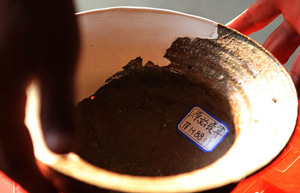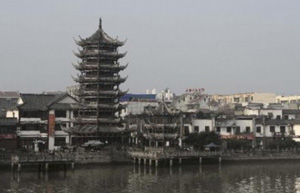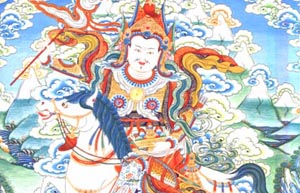Two ancient city ruins found under Wangjinglou heritage site
2011-01-14 16:39:45
In a recent archaeological excavation of Wangjinglou heritage site in Xinzheng City of Henan Province, Zhengzhou Academy of Cultural Relics and Archaeology accidentally discovered two large-scale ancient city ruins from the Xia and Shang dynasties with a total area of nearly 1.7 million square meters.
China's earliest known porcelain unearthed
2011-01-14 16:39:45
 A proto-porcelain dating back to Shang Dynasty (1600 B.C. - 1046 B.C.) was unearthed at an archeological site in Xinzheng, central China's Henan Province on Jan. 12, 2011.
A proto-porcelain dating back to Shang Dynasty (1600 B.C. - 1046 B.C.) was unearthed at an archeological site in Xinzheng, central China's Henan Province on Jan. 12, 2011.
60 Han dynasty beacon towers found in Gansu
2011-01-14 16:04:13
A total of more than 60 ancient beacon towers from the Han dynasty were discovered at Subei Mongolia Autonomous County in Gansu Province.
600 mln yuan poured in for ancient county remediation
2011-01-14 16:04:13
 Photo taken on Jan. 13, 2011 shows the scenery of Luojiang County of Deyang City, southwest China's Sichuan Province. Local government has invested some 600 million yuan RMB (more than 90 million U.S. dollars) on environmental remediation, improving local people's livelihood, attracting more investments and promoting the development of culture industry.
Photo taken on Jan. 13, 2011 shows the scenery of Luojiang County of Deyang City, southwest China's Sichuan Province. Local government has invested some 600 million yuan RMB (more than 90 million U.S. dollars) on environmental remediation, improving local people's livelihood, attracting more investments and promoting the development of culture industry.
Ruins of two 4000-year-old cities discovered in central China
2011-01-14 15:16:16
Chinese archeologists have unearthed the ruins of two ancient cities in the central China province of Henan.The cities date back 4,000 years, Ma Xiaolin, deputy director of Henan's provincial cultural heritage bureau, said Thursday.
New archaeological discovery in Suzhou
2011-01-14 14:42:55
A historic site of an ancient town, located in the southwestern part of Suzhou in East China's Jiangsu Province, was found last year. The announcement of this discovery was held on Tuesday in Suzhou.
6 major archeological finds in China in 2010
2011-01-13 14:26:43
 China has announced its six major archeological finds in the year 2010. That include the Nan Ao One sunken ship, and a compound of porcelain kilns in east China's Zhejiang Province.
China has announced its six major archeological finds in the year 2010. That include the Nan Ao One sunken ship, and a compound of porcelain kilns in east China's Zhejiang Province.
Confucius statue unveiled in Beijing
2011-01-13 14:26:43
A statue of Confucius was unveiled to the public on Tuesday in Beijing. The giant statue is erected in the north square of the National Museum of China.The statue measures 9.5 meters in height.
China and Kenya joint excavation project on islands
2011-01-13 14:26:43
Archeologists from both China and Kenya are joining forces in a large scale excavation project on islands off the coast of Kenya. Recently a team of Chinese experts were dispatched to the area, signaling the beginning of a 3-year research commitment.
"King Gesar" epic told through Tang-ka paintings
2011-01-13 14:14:22
 The Tibetan epic "King Gesar" is the world's longest story. Many books and TV series have told this story in the past, but for the first time it's being presented using Tang-ka paintings.Tang-ka is a traditional painting which is commonly found hanging in monasteries or family altars in China's Tibetan Autonomous Region.
The Tibetan epic "King Gesar" is the world's longest story. Many books and TV series have told this story in the past, but for the first time it's being presented using Tang-ka paintings.Tang-ka is a traditional painting which is commonly found hanging in monasteries or family altars in China's Tibetan Autonomous Region.
Chinese gov't continues efforts to protect intangible cultural heritage
2011-01-12 16:11:28
The Chinese government continues its efforts to protect the intangible cultural heritage by training the professional staff in the country's culture departments.More than 50 people participated in a training program Saturday in Guiyang, southwest China's Guizhou Province.
China mulls ban on unapproved foreign surveys of intangible cultural heritage
2011-01-12 16:06:26
Foreign organizations and individuals will have to obtain government approval before conducting surveys of intangible cultural heritage (ICH) in China, according to a revised draft law.